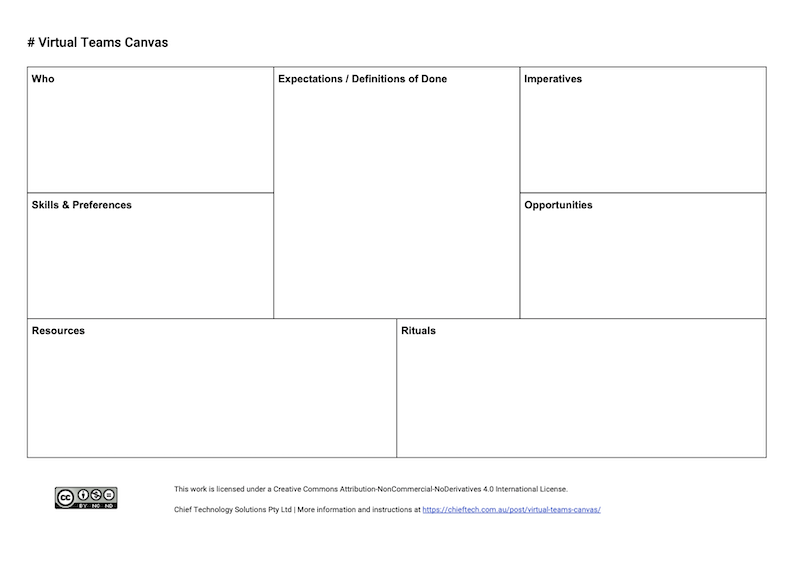A brief guide to successful virtual teams (revisited)
2020-03-03
Many years ago, I blogged some guidelines I was using to help coach people working in virtual teams. With an increased interest in remote working, which right now is mainly because of the coronavirus, I was thinking about if these guidelines might still be relevant in light of changing technology and workstyles.
My premise for those original guidelines was that many people were already working as part of virtual or distributed teams if even they didn't recognise it. Since that time, the rise of activity-based working and its derivatives mean that even more people are likely to be spending time working in a distributed manner.
Collaboration technologies have changed a lot over the last decade, for the most part offering a better user experience and anytime, anywhere access. However, the fundamentals aren't that much different, and these guidelines were technology agnostic.
So on balance, I think they are still relevant. However, the format might need an update, so this time, I've created a collaboration canvas template, which you can use to help think about how to set up a virtual team to be successful.
Canvas Template

Download your free copy: Download Now
Instructions
The canvas is divided into seven sections, and I would suggest completing it in the following way:
Step 1. Who + Imperatives
Given a choice, many people would continue doing what they are most comfortable doing. Successful virtual teams recognise that the willingness to work as a virtual team is based on understanding the balance between necessity and opportunity. So we first want to understand:
- Who - Identify all participants and other stakeholders.
- Imperatives - What is the necessity to work this way?
Once you have addressed these parts, reflect on those two elements and think about the expected outputs of the team (i.e. goals, objective, processes, etc.). But just note these to the side for the moment, as we will come back to them.
Step 2. Skills & Preferences + Opportunities
It is essential that you work realistically with the skills people have, as it will affect their capacity to work as a leader or part of a virtual team or remote workgroup. A good way to think about this is by framing it in terms of strengths and weaknesses. Also think about the workstyle preferences of participants and stakeholders, including:
- How would each person prefer to receive information and interact with other people?
- How will people coordinate the work or outcomes that need to be achieved?
- How will you deal with disagreements or conflict?
And opposite to the Imperatives you have already identified, think about the opportunities a virtual team could provide to the participants and stakeholders. Virtual teams can have many positive benefits.
Step 3. Expectations / Definitions of Done
Now reflect on all the elements completed so far (Who, Imperatives, Skills & Preferences, and Opportunities) and think again about the expected outputs of the team. For this step, we need to define what success looks like to the team (which is not necessarily the same at their actual goals, objective, processes, etc.). Some issues to consider include: Communication; Time management; Oversight; Leadership and motivation; Dealing with conflict; and Performance management.
Remember, managers need to have some system of control, and similarly, staff need to have clear expectations, roles and responsibilities assigned, but we want to avoid micromanagement.
Step 4. Resources + Rituals
In co-located teams, work practices and business culture for how people are managed, how people communicate, and how people work together are typically implicit and assumed. However, in a virtual team, we must surface these practices and norms through explicit and deliberate management.
With that in mind, in this final step, we are going to think about:
- Resources – what software, hardware, and other resources do you need to ensure people have what they need to meet the Expectations / Definitions of Done you have defined?
- Rituals – these are clear, regular and explicit communication systems that will be put in place, using the Resources you have identified.
No single technology is essential to the success of a remote team or workgroup – technology is only necessary because it enables communication in virtual workspaces. When picking Resources, consider:
- What information and knowledge need to be shared?
- How will people coordinate the work or outcomes that need to be achieved?
When planning your Rituals, I recommend:
- Use a combination of communication models – pick the method and content that match the needs of your virtual workspace;
- Allow opportunities for "socialisation" and trust-building;
- Be practical and considerate of team members other work commitments and other personal issues;
- Don't forget to build in time for informal 1-to-1 communication outside the group communication plan; and
- How will you reward success and recognise achievements?
And don't forget to take into consideration that many people may find themselves as part of both a physical and one or more virtual teams, adding to the management complexity of the situation. It is also essential to know when and when not to use technology to communicate.
Some final tips
Now that you have completed your virtual teams' canvas, if you didn't involve your team in planning it don't forget to socialise it with them. It can also be helpful to establish a group communication plan, protocols, roles and responsibilities, as this will provide the routine to support your rituals.
You should also review and refresh the canvas periodically, as team members and your Expectations / Definitions of Done will change over time.